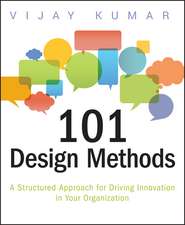Intersection: How Enterprise Design Bridges the Gap between Business, Technology, and People
Autor Milan Guentheren Limba Engleză Paperback – 21 oct 2012
This book gives designers, entrepreneurs, innovators, and leaders a model and a comprehensive vocabulary for tackling such deep-rooted challenges. The Enterprise Design framework cuts through the complexity of Strategic Design work, showing how to navigate key aspects and bridge diverging viewpoints. In 9 case studies, the author looks at the way companies like SAP, BBVA, IKEA, and Jeppesen (a Boeing Company) apply design thinking and practice to shape their enterprises. Moving from strategy to conceptual design and concrete results, Intersection shows what is relevant at which point, and what expertise to involve.
- Teaches how to align business strategy with Brand Identity, Customer Experience, and Enterprise Architecture initiatives as part of a consolidated enterprise-wide design practice to achieve stakeholder value
- Provides a framework for designing systems, products and services as the building blocks of a consistent and coherent experience for all stakeholders in the wider enterprise, joining strategic considerations with the delivery of tangible outcomes
- Explains how to make results such as websites, apps, objects, platforms, or environments part of a larger system that orchestrates enterprise touchpoints with people
Preț: 252.01 lei
Preț vechi: 295.52 lei
-15% Nou
48.23€ • 50.17$ • 39.82£
Carte tipărită la comandă
Livrare economică 07-21 aprilie
Specificații
ISBN-10: 0123884357
Pagini: 462
Ilustrații: Approx. 100 illustrations
Dimensiuni: 191 x 235 x 23 mm
Greutate: 0.95 kg
Editura: ELSEVIER SCIENCE
Public țintă
Information managers, information architects, IT execs/C level managers, consultants, enterprise/ business architects, Web Designers/Developers, Intranet developers and managers, Information Managers, software application developers, students in design management classes in an IT / Design course or MBA, and HCI researchers and practitioners.Cuprins
Introduction
Part I: Thoughts on Strategic Design
Chapter 1: The Relationship Challenge
Chapter 2: Blurring Boundaries
Chapter 3: The Design-Minded Enterprise
Part II: The Enterprise Design Framework
Chapter 4: Big Picture
Chapter 5: Anatomy
Chapter 6: Frames
Chapter 7: Design Space
Chapter 8: Rendering
Part III: Design Approach
Chapter 9: Design Process
Chapter 10: Design Program
Outlook
Recenzii
Descriere
Many organizations struggle with the dynamics and the complexity of today's social ecosystems that connect everyone and everything, everywhere and all the time. Facing challenges at the intersection of business models, technical developments, and human needs, modern enterprises must overcome the siloed thinking and isolated efforts of the past, and instead address their relationships to people holistically. In Intersection, Milan Guenther introduces a Strategic Design approach that aligns the overarching efforts of Branding, Enterprise Architecture, and Experience Design, and sets them on a common course to shape tomorrow’s enterprises.
This book gives designers, entrepreneurs, innovators, and leaders a model and a comprehensive vocabulary for tackling such deep-rooted challenges. The Enterprise Design framework cuts through the complexity of Strategic Design work, showing how to navigate key aspects and bridge diverging viewpoints. In 9 case studies, the author looks at the way companies like SAP, BBVA, IKEA, and Jeppesen (a Boeing Company) apply design thinking and practice to shape their enterprises. Moving from strategy to conceptual design and concrete results, Intersection shows what is relevant at which point, and what expertise to involve.
- Teaches how to align business strategy with Brand Identity, Customer Experience, and Enterprise Architecture initiatives as part of a consolidated enterprise-wide design practice to achieve stakeholder value
- Provides a framework for designing systems, products and services as the building blocks of a consistent and coherent experience for all stakeholders in the wider enterprise, joining strategic considerations with the delivery of tangible outcomes
- Explains how to make results such as websites, apps, objects, platforms, or environments part of a larger system that orchestrates enterprise touchpoints with people


















